2023 Genesis G90 sets ultra-luxury standard
By John Gilbert
Your first look at a 2023 Genesis G90 may stop you in your tracks for the level of sheer luxury the car emits. In this era where many car-makers are discontinuing cars of all varieties for the sake of SUVs of all shapes and sizes, South Korea’s Hyundai has pulled off a remarkable and surprising new luxury sedan.
General Motors, Ford and what used to be Chrysler Corporation have made more news announcing the discontinuing of new sedans than by introducing new models over the last five years, and while Hyundai has SUVs that fit into every niche, it also is building new sedans, and spectacular ones as well.
And that’s just from the outside, where the distinctive grille and the sleek, autobahn-cruising shape attract you from every angle. After carefully perusing the headlights, with their encased battery of small beam LEDs wrap around both corners, to the silhouette, and back to the gently sloping rear window and trunk lid, the real surprises still are awaiting inside.
That is, if you can get in. The four door handles fit flat into the bodywork, and only if you have the key fob do they pop out for your use as you approach. Once they show themselves, you easily pull on them to open the doors. Closing the doors is easier, because you can merely grab the hand-fitting armrest and pull it shut. But you don’t have to. No, you can push the right button and observe the door closing itself, firmly and securely.
When you reach your destination, a little practice makes getting out easy, too. Without it, you may hunt for a few minutes to locate anything that looks like an inside door release. But it’s there, and when you push the button, the door pops open, all by itself.
Such gadgetry might seem annoying to old-time drivers, who liked it best when everything was simple. But the G90 is no commonplace people hauler. It is an exquisite vehicle that rises above the old term “luxury” sedan to easily qualify as “ultra-luxury sedan.” So if a car has all this luxury built in, it is going to cost you, big time, and the G90 fits that bill, too.
The test G90 I drove for a week was gleaming metallic white pearls which allows the black grille and blackened alloy wheels to stand out. Its base price is #98,700, and as-tested, this one stickered for $101,295.
That’s a lot of money for any car, especially one not made by Mercedes, BMW or Audi, or Lexus, but the Genesis G90 actually layers on the luxury and high-tech features to out-German the top models of those tradition German luxury car leaders, as well as to tackle Toyota’s top Lexus luxury cars.
Since bursting on the mainstream sedan scene just over a decade ago, Hyundai — and its adopted partner kia — have risen steadily to the top in quality and performance to match its similarly rising levels of refinement and durability.
Hyundai brought out the Genesis as its top model in 2015, and after refining that original model it decided to split Genesis off into its own bracket, for better focus on challenging the top luxury autos in the industry.
The last model was very good, with a G90 that was similar to but larger than the G80 sedan, and those two spun off some very impressive personal SUVs like the GV60, GV70, GV80 and GV90.
Powering the previous G90 was the very good duo of the 3.3 V6 or the high-tech DOHC Tau V8, which produced tremendous power. But Hyundai has chosen to replace the V8 in the car with a twin-turbocharged 3.6 V6 in base form, and a twin-supercharged version of the high-tech V6 that produces 409 horsepower and 405 foot-pounds of torque. That’s slightly less horsepower, but more torque at the same time, peaking at low RPMs to provide maximum towing and pulling power.
Coupled with the Hyundai-built 8-speed automatic, rear air suspension and adaptive rear-wheel steering, hammering the G90 through a tight turn provides a new definition of sports sedan. All those features work so well integrated with Hyundai’s top-level safety controls, such as its unexcelled lane-departure and lane-centering precision that are a joy to experience.
This is not a lightweight midsize or compact that you can hurl around on an autocross course on weekends, but it does handle convincingly as though it might like to try it.
The immaculate stitching and attention to fit and finish details inside add to the whole picture, but any family with growing kids know they all clamor to sit in the front passenger seat whenever you head for the shopping center or playground. Well, be prepared for a change in attitude with the G90, because everybody — kids, adults and grandparents — will clamor to sit in the right rear.
You climb inside and realize the seat itself is something special, then you start fiddling with the controls and learn how to raise the footres
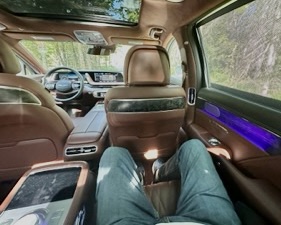
Right rear seat is of first-class jetliner stature, with recline, massage, footrest, and ambient-lighting features..
t as you slightly recline the seat back. You also have sunshades on the rear window and side windows, and you have your own controls for the climate control and solitude. Then you can ask the driver to please select “chauffeur” on the drive control switch, which softens the rear suspension just slightly via the air shocks for a more luxurious ride.
I think the engineers were wise to build in the feel and controls of a top-flight sports sedan rather than a big-screen dominated luxury boat, because no matter how much luxury you might want, when it comes to driving you still want a precise, good-handling sporty-sedan flair to anticipate your every instinct and translate them into action.
I have a couple of concerns about the G90 — which overwhelmed the Motor Trend staff as it was selecting the G90 as its 2023 Car of the Year — and it has to do with our driving climate in Duluth, Minnesota, where I live. Last winter, we broke the all-time records for snow and ice storms and accumulation, and all vehicles were challenged by such weather. True, the heated seats and auto-start can handle most of those conditions, but we have our extremes.
For example, it’s fun to show off the fancy receding door handles, but I need to know if, after standing up to a 20-inch snowfall during an ice-storm blizzard in January, will those door handles open at the slight influence of approaching with the key fob? My guess is that you might need another bit of training on how to open those doors if they are encased in 3 inches of solid ice.


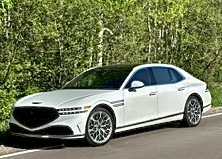
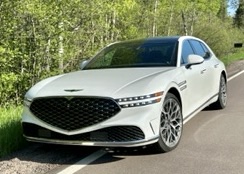
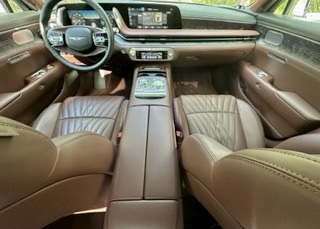
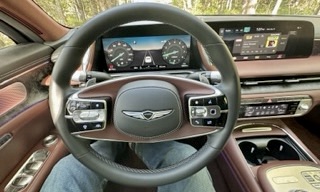
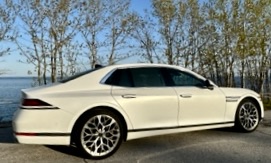
 John Gilbert is a lifetime Minnesotan and career journalist, specializing in cars and sports during and since spending 30 years at the Minneapolis Tribune, now the Star Tribune. More recently, he has continued translating the high-tech world of autos and sharing his passionate insights as a freelance writer/photographer/broadcaster. A member of the prestigious North American Car and Truck of the Year jury since 1993. John can be heard Monday-Friday from 9-11am on 610 KDAL(www.kdal610.com) on the "John Gilbert Show," and writes a column in the Duluth Reader.
John Gilbert is a lifetime Minnesotan and career journalist, specializing in cars and sports during and since spending 30 years at the Minneapolis Tribune, now the Star Tribune. More recently, he has continued translating the high-tech world of autos and sharing his passionate insights as a freelance writer/photographer/broadcaster. A member of the prestigious North American Car and Truck of the Year jury since 1993. John can be heard Monday-Friday from 9-11am on 610 KDAL(www.kdal610.com) on the "John Gilbert Show," and writes a column in the Duluth Reader.